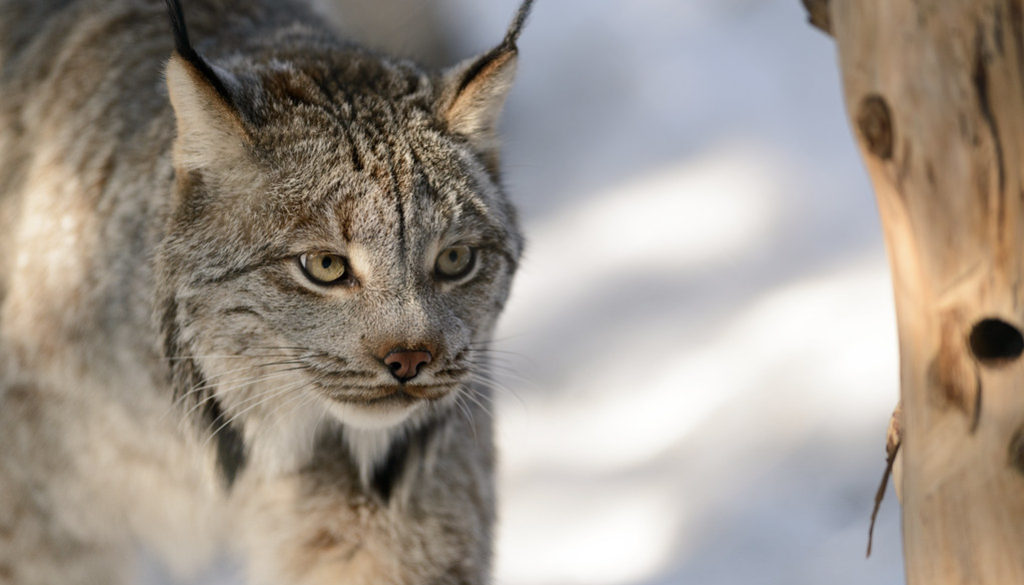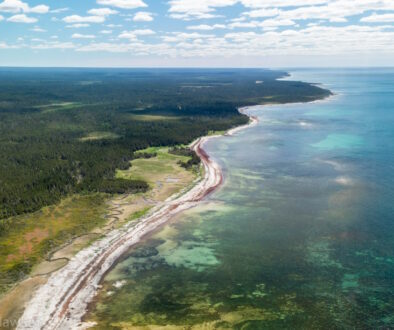10 Underrated species of the Acadian Forest

Spreading north across the Maritimes to meet the Boreal treeline, lies an ecosystem deeply intertwined with the identity of New Brunswick and its people. Surrounded by the sea, dotted with wetlands, and providing habitat for all sorts of flora and fauna, the Acadian Forest breathes life into our region. As New Brunswickers, many of us grow up exploring amongst the trees of the Acadian Forest. Picking colourful leaves as they fell in autumn and collecting pinecones from the evergreens, we may not have known that we were living in such a unique ecosystem.
The Acadian Forest makes up just 2.2% of Canada’s total forest but is home to a great diversity of plants and animals, from the tall and towering trees to the microbes of the forest floor. Of course, there are many plants and animals in the forest that deserve celebration, but these ten species, while some are quite common, are deserving of some extra special recognition as unsung heroes of New Brunswick’s Acadian Forest.
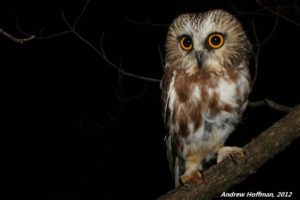
“Aegolius acadicus (Northern Saw-whet Owl)” by Andrew Hoffman is licensed under CC BY-NC-ND 2.0
1. Northern saw-whet owl – I don’t know about you, but when I think of owls, I picture a big bird with a bigger head and even bigger eyes. Named for its unique call, which sounds like the whetting, or sharpening, of a mill saw, the northern saw-whet owl weighs in at just 65-151 grams and about 20cm tall, not much bigger than a Tim Horton’s medium cup of coffee. As a bird that prefers to nest in deciduous trees, but sleep in the conifers, while enjoying a nearby lake or river, the Acadian Forest is the perfect habitat for this little owl.
2. Eastern hemlock – When we think of New Brunswick’s trees, many people would think of the impressive white pine or the sweet sugar maple, but lying lower in the canopy is the shade-tolerant eastern hemlock, another champion of the Acadian Forest. Living to be more than 800 years old, this tree is among the most important species in the forest. The eastern hemlock provides food and habitat to more than 120 wildlife species from insects to mammals.
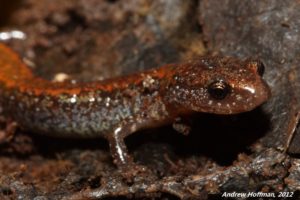
3. Red-backed salamander – An often-forgotten amphibian, the red-backed salamander is just one of several salamander species native to New Brunswick. This small salamander takes up residence in moist habitats of the Acadian forest, like in rotting wood or under leaf litter on the forest floor. When under attack, the red-backed escapes from predators by dropping its tail! It will eventually grow a new one, though the new appendage may be duller in colour. No tail, no problem!
4. Little brown bat – Bats are amazing animals and the little brown bat that calls the Acadian Forest home is no exception. This tiny species weighs less than 15 grams and can eat more than 1000 mosquitos in just one hour! Historically this bat has been abundant in Canada and not a concern in conservation, but in 2014 the species was emergency listed as endangered under Canada’s Species At Risk Act due to very fast population declines as the infamous white-nose syndrome swept across the country. This fungus-caused disease continues to plague bat populations across the country, including our local little brown bats.
5. Lowbush blueberry – Is there anything better than fresh picked blueberries in your morning muffins or weekend pancakes? The Acadian Forest is home to many edible plants, but perhaps none as delicious as the lowbush blueberry. A favourite food to humans and animals alike, this species is more than just a yummy treat in the forest! Lowbush blueberry can live in acidic environments, is fire-tolerant, and can spread to dominate large areas of the forest where there is lots of sun.

6. Chicken-of-the-woods mushroom – Growing on tree trunks in clusters of bright orange, fan-shaped mushrooms, you’ve probably seen this common species on many afternoon strolls through the Acadian Forest. While the mushroom is named for its chicken-like flavour, others describe it as lemony, meaty, and lobster-like! With that flavour profile, it’s no surprise that this species is considered a delicacy in some parts of the world. While this mushroom is edible, it can cause upset stomach and can absorb the oils of the host tree, which can be toxic to people. Always consult an experienced professional before picking and consuming fungi!
7. Ruffed grouse – A common bird that we often associate with hunting, the ruffed grouse gets outshined by its flashier cousin, the ring-necked pheasant. This species is hearty and thrives in younger forests where some light disturbance, like logging, occurs. An expert in camouflage, the ruffed grouse is cryptically coloured to match the forest and makes slow and purposeful movements to avoid detection by predators. In the winter, this bird will bury itself in the snow to roost, sometimes surprising visitors to the forest by emerging from a crisp blanket of snow!
8. Wood frog – As the most widely distributed amphibian in Canada, the wood frog is found in every province and territory! While it may not be unique to New Brunswick, this species thrives in the Acadian Forest where there is lots of leaf litter and a damp habitat. The wood frog even does well through our tough winters by hibernating under logs or leaves on the forest floor. This frog is even freeze-tolerant and can change to a darker colour to absorb the sun’s rays! It is no surprise that the wood frog thrives in this forest, especially since they lay up to 2000 eggs in a breeding season.
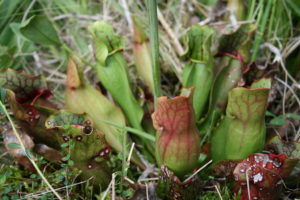
9. Purple pitcher plant – Two words: carnivorous plant. The purple pitcher plant thrives in nutrient-poor environments because of its ability to feed on nutritious insects. Using bright colours and sweet nectar to attract insects like ants and flies to the liquid-filled pitcher, bugs are trapped and digested for their nutrients. The purple pitcher plant is one of only 18 carnivorous plants in all of Canada and the only pitcher plant in our country!
10. Canada lynx – You may not think the lynx is underrated, but as a ferocious predatory cat this species doesn’t get enough credit! As an expert hunter, this medium-sized cat makes up for what it lacks in speed with exceptional hearing, keen eyesight, and a build made for stealth in the snowy Canadian winters. In New Brunswick, very little is known about this elusive species. The Canada lynx is currently listed as endangered in our province, and with its need for a large territory this species could benefit from greater protection of wilderness in the Acadian Forest.
While these ten species may be just a few examples among many that deserve their 15-seconds of fame, the Acadian Forest is bursting with life – full of vibrant communities and important ecosystems that connect New Brunswickers to nature. By preserving wilderness and protecting our forest ecosystems from ever-increasing threats, we can ensure that all plants and animals can thrive now and into the future. This is why CPAWS-NB is working hard to see an increase in protected area coverage that will support healthy and lively ecosystems in our province.
Header photo “Canada Lynx Walking” by Eric Kilby is licensed under CC BY-SA 2.0
Julie Reimer is a PhD student at the Memorial University of Newfoundland and a Board Member of CPAWS-NB. Having worked in the whale watching industry in New Brunswick and conducted her Master’s research on conservation planning for the North Atlantic right whale, Julie is an advocate for MPAs in New Brunswick. Julie’s current research attempts to see the “bigger picture” of conservation, reaching beyond protected areas to understand the synergies between conservation actions and ocean industries. To connect with Julie, visit http://juliereimer.wixsite.com/hello.

